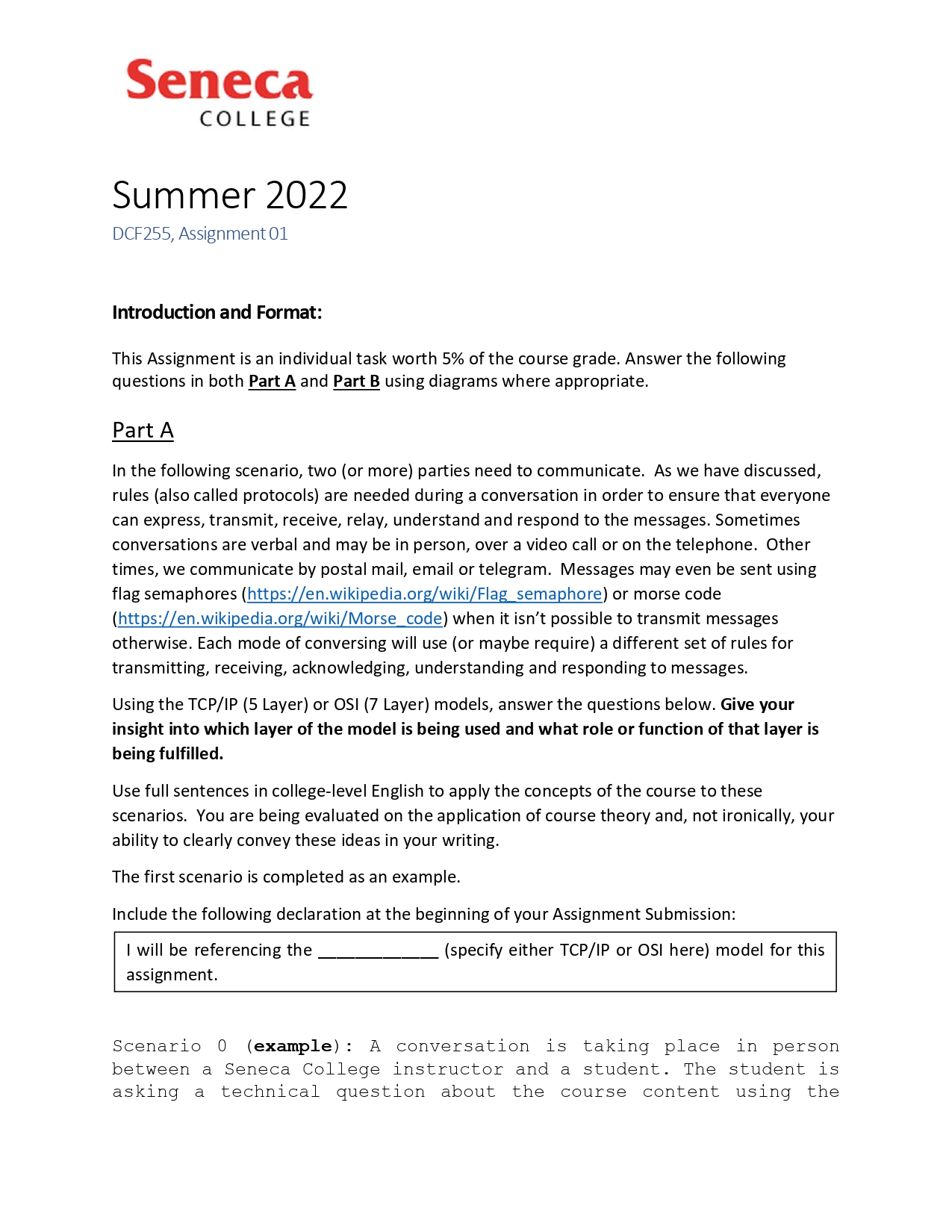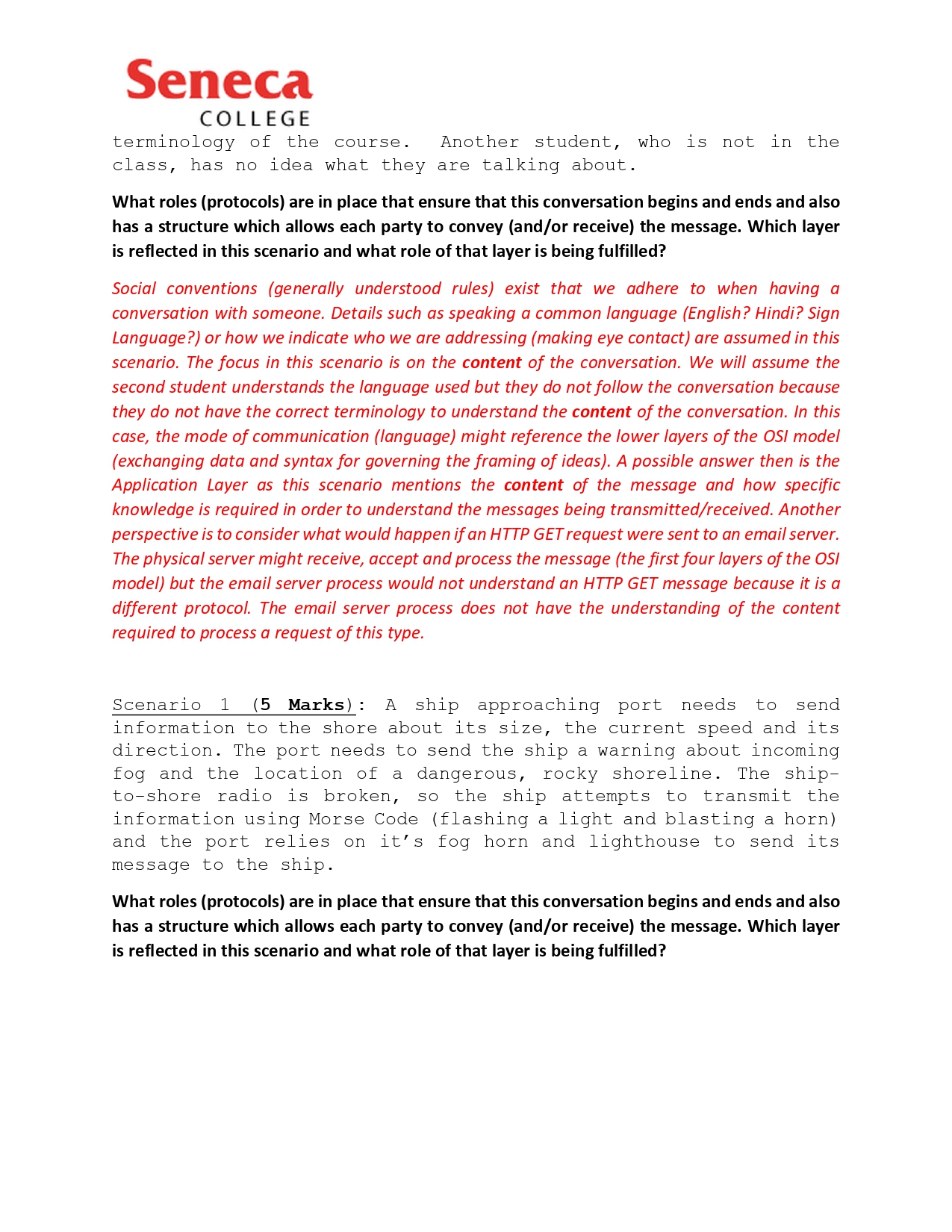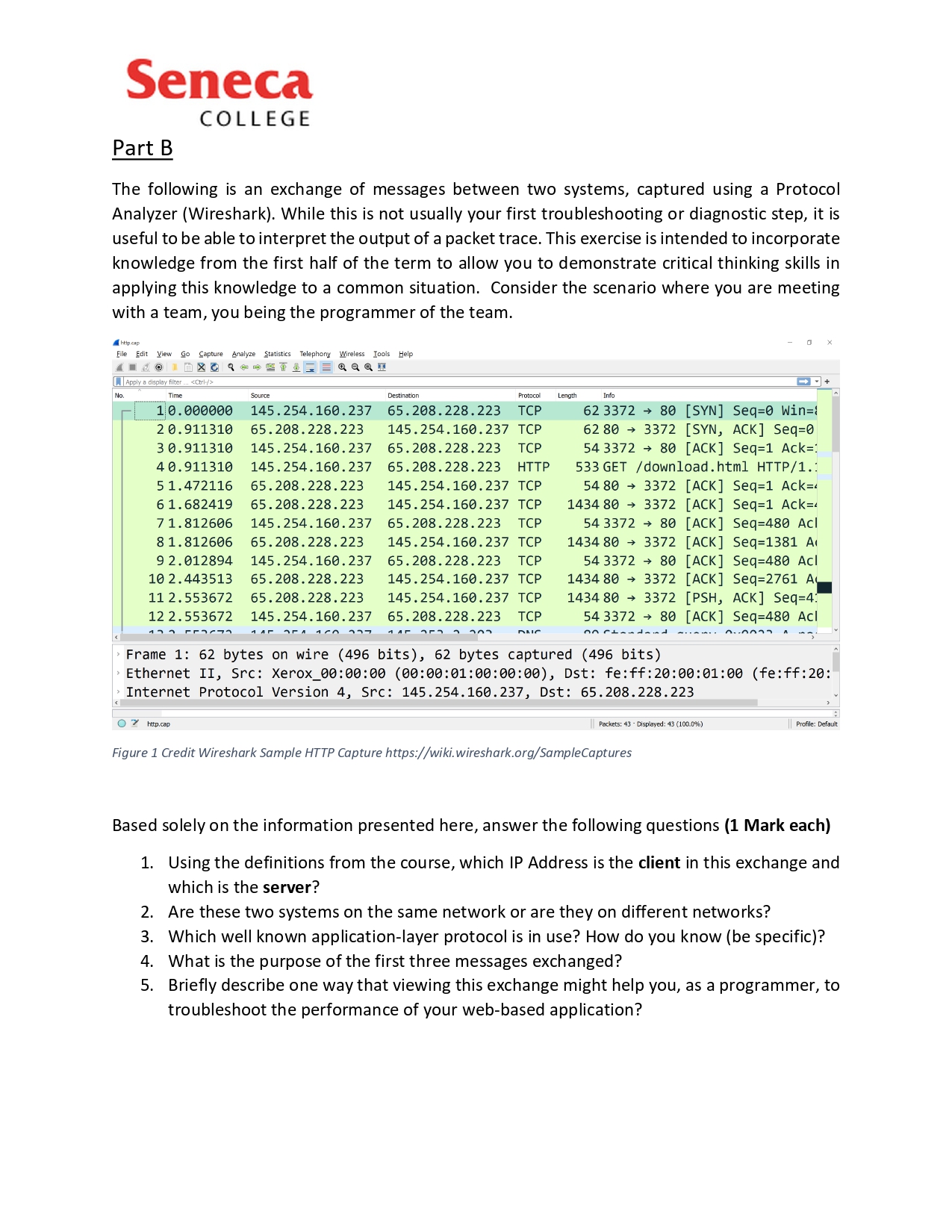Answered step by step
Verified Expert Solution
Question
1 Approved Answer
Seneca COLLEGE Summer 2022 DCF255, Assignment 01 Introduction and Format: This Assignment is an individual task worth 5% of the course grade. Answer the



Seneca COLLEGE Summer 2022 DCF255, Assignment 01 Introduction and Format: This Assignment is an individual task worth 5% of the course grade. Answer the following questions in both Part A and Part B using diagrams where appropriate. Part A In the following scenario, two (or more) parties need to communicate. As we have discussed, rules (also called protocols) are needed during a conversation in order to ensure that everyone can express, transmit, receive, relay, understand and respond to the messages. Sometimes conversations are verbal and may be in person, over a video call or on the telephone. Other times, we communicate by postal mail, email or telegram. Messages may even be sent using flag semaphores (https://en.wikipedia.org/wiki/Flag_semaphore) or morse code (https://en.wikipedia.org/wiki/Morse_code) when it isn't possible to transmit messages otherwise. Each mode of conversing will use (or maybe require) a different set of rules for transmitting, receiving, acknowledging, understanding and responding to messages. Using the TCP/IP (5 Layer) or OSI (7 Layer) models, answer the questions below. Give your insight into which layer of the model is being used and what role or function of that layer is being fulfilled. Use full sentences in college-level English to apply the concepts of the course to these scenarios. You are being evaluated on the application of course theory and, not ironically, your ability to clearly convey these ideas in your writing. The first scenario is completed as an example. Include the following declaration at the beginning of your Assignment Submission: I will be referencing the assignment. (specify either TCP/IP or OSI here) model for this Scenario 0 (example): A conversation is taking place in person between a Seneca College instructor and a student. The student is asking a technical question about the course content using the Seneca COLLEGE terminology of the course. Another student, who is not in the class, has no idea what they are talking about. What roles (protocols) are in place that ensure that this conversation begins and ends and also has a structure which allows each party to convey (and/or receive) the message. Which layer is reflected in this scenario and what role of that layer is being fulfilled? Social conventions (generally understood rules) exist that we adhere to when having a conversation with someone. Details such as speaking a common language (English? Hindi? Sign Language?) or how we indicate who we are addressing (making eye contact) are assumed in this scenario. The focus in this scenario is on the content of the conversation. We will assume the second student understands the language used but they do not follow the conversation because they do not have the correct terminology to understand the content of the conversation. In this case, the mode of communication (language) might reference the lower layers of the OSI model (exchanging data and syntax for governing the framing of ideas). A possible answer then is the Application Layer as this scenario mentions the content of the message and how specific knowledge is required in order to understand the messages being transmitted/received. Another perspective is to consider what would happen if an HTTP GET request were sent to an email server. The physical server might receive, accept and process the message (the first four layers of the OSI model) but the email server process would not understand an HTTP GET message because it is a different protocol. The email server process does not have the understanding of the content required to process a request this type. Scenario 1 (5 Marks): A ship approaching port needs to send information to the shore about its size, the current speed and its direction. The port needs to send the ship a warning about incoming fog and the location of a dangerous, rocky shoreline. The ship- to-shore radio is broken, SO the ship attempts to transmit the information using Morse Code (flashing a light and blasting a horn) and the port relies on it's fog horn and lighthouse to send its message to the ship. What roles (protocols) are in place that ensure that this conversation begins and ends and also has a structure which allows each party to convey (and/or receive) the message. Which layer is reflected in this scenario and what role of that layer is being fulfilled? Seneca COLLEGE Part B The following is an exchange of messages between two systems, captured using a Protocol Analyzer (Wireshark). While this is not usually your first troubleshooting or diagnostic step, it is useful to be able to interpret the output of a packet trace. This exercise is intended to incorporate knowledge from the first half of the term to allow you to demonstrate critical thinking skills in applying this knowledge to a common situation. Consider the scenario where you are meeting with a team, you being the programmer of the team. http.cap Eile Edit View Go Capture Analyze Statistics Telephony Wireless Jools Help IXC8+? No. Apply a display filter... Time Source 07 http.cap Destination Protocol Length 10.000000 145.254.160.237 65.208.228.223 TCP 20.911310 65.208.228.223 145.254.160.237 TCP 30.911310 145.254.160.237 65.208.228.223 TCP 40.911310 145.254.160.237 65.208.228.223 HTTP 51.472116 65.208.228.223 145.254.160.237 TCP 61.682419 65.208.228.223 145.254.160.237 TCP 71.812606 145.254.160.237 65.208.228.223 TCP 81.812606 65.208.228.223 145.254.160.237 TCP 92.012894 145.254.160.237 65.208.228.223 TCP 10 2.443513 65.208.228.223 145.254.160.237 TCP 112.553672 65.208.228.223 145.254.160.237 TCP 12 2.553672 145.254.160.237 65.208.228.223 TCP DUC 160 327 445 50 Info 62 3372 80 [SYN] Seq=0 Win=> 62 80 3372 [SYN, ACK] Seq=0 54 3372 80 [ACK] Seq=1 Ack=1 533 GET /download.html HTTP/1.: 54 80 3372 [ACK] Seq=1 Ack= 1434 80 3372 [ACK] Seq=1 Ack= 54 3372 80 [ACK] Seq=480 Acl 1434 80 3372 [ACK] Seq=1381 A 54 3372 80 [ACK] Seq=480 Acl 1434 80 3372 [ACK] Seq-2761 Au 1434 80 3372 [PSH, ACK] Seq=4 54 3372 80 [ACK] Seq=480 Acl standing Frame 1: 62 bytes on wire (496 bits), 62 bytes captured (496 bits) Ethernet II, Src: Xerox 00:00:00 (00:00:01:00:00:00), Dst: fe:ff:20:00:01:00 (fe:ff:20: Internet Protocol Version 4, Src: 145.254.160.237, Dst: 65.208.228.223 Packets: 43 Displayed: 43 (100.0%) + 0.0037 Figure 1 Credit Wireshark Sample HTTP Capture https://wiki.wireshark.org/SampleCaptures Profile: Default Based solely on the information presented here, answer the following questions (1 Mark each) 1. Using the definitions from the course, which IP Address is the client in this exchange and which is the server? 2. Are these two systems on the same network or are they on different networks? 3. Which well known application-layer protocol is in use? How do you know (be specific)? 4. What is the purpose of the messages exchanged? 5. Briefly describe one way that viewing this exchange might help you, as a programmer, to troubleshoot the performance of your web-based application?
Step by Step Solution
There are 3 Steps involved in it
Step: 1

Get Instant Access to Expert-Tailored Solutions
See step-by-step solutions with expert insights and AI powered tools for academic success
Step: 2

Step: 3

Ace Your Homework with AI
Get the answers you need in no time with our AI-driven, step-by-step assistance
Get Started


